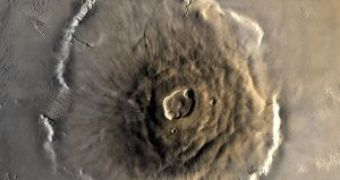30 years ago, the cameras of the Viking Mission to Mars captured incredible images of canyons and craters, but also found glaciers at the base of the majestic volcanoes and mountains dotting the mid-latitude and tropical regions. The mystery of how these glaciers formed has finally been resolved with the help of an innovative blend of geological observations and climate modeling.
In the last two years, Brown University planetary geologist James Head and other Mars experts have offered up mounting evidence that these ice-rich landforms - which appear to ooze out of valleys in the Eastern Hellas region or puddle on the western flanks of the three giant volcanoes known as the Tharsis Montes - are the remnants of geologically recent glaciers.
But how could ice form so far from the planet's poles? Long-ago landslides? Upwelling from an underground reservoir?
The team of American and French scientists has argued that the snow is the source of glacial deposits found of Mars. "What we found," Head said, "was that the glaciers were formed from snow brought from the polar regions."
A few million years ago, Head and the team explain, the axis of Mars was tilted in such a way that the poles were pointing dramatically closer to the sun. Sun rays hit the polar ice caps nearly head on, releasing massive amounts of water vapor into the atmosphere. Monsoon-like winds carried the water vapor south, up and over the slopes of the Tharsis Montes volcanoes and Olympus Mons, the solar system's largest volcano. The vapor cooled, condensed and fell in the form of snow. Over time, the snow turned to ice, the ice formed glaciers, and the glaciers created the deposits seen today.
The team arrived at their finding using a climate model that simulated the present-day Mars water cycle but assumed a 45-degree axial tilt found on the planet millions of years ago. The model's predictions matched almost exactly and direct observational evidence of ice accumulation from images taken by the Mars Express, Mars Global Surveyor and Mars Odyssey orbiters.
"The findings are important because they tell us that Mars has experienced big climate changes in the past, the kinds of climate change that led to the Great Ice Age here on Earth," said Head. "The findings are also interesting because this precipitation pattern may have left pockets of ice scattered across Mars. This is good information for NASA as officials plan future space missions, particularly with astronauts."
The Martian precipitation cycle the scientists described is similar to the one on Earth that routinely blankets mountainous regions such as the Rockies in snow. Similar tropical mountain glaciers to the ones described in the paper can also be found on Earth in places such as Mount Kilimanjaro in Africa or the Andean peaks in South America.
Picture Credits: Olympus Mons, the solar system's largest volcano (NASA)

 14 DAY TRIAL //
14 DAY TRIAL //